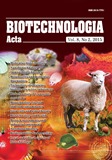ISSN 2410-7751 (Print)
ISSN 2410-776X (Online)

"Biotechnologia Acta" V. 8, No 2, 2015;
https://doi.org/10.15407/biotech8.02.107
Р. 107-111, Bibliography 16, Ukrainian
Universal Decimal classification: 546.26.043
IMMOBILIZATION OF ANTITUMOR DRUGS ON NANOPARTICLES
Yu. I. Prylutskyy1, М. А. Zabolotnyy1, G. I. Solyanyk2, L. M. Kirkilevskaya2
1Taras Shevchenko National University of Kyiv, Ukraine
2Kavetsky Institute of Experimental Pathology, Oncology and Radiobiology of the National Academy of Sciences of Ukraine, Kyiv
3National Medical University of the National Academy of Medical Sciences of Ukraine, Kyiv
Literature data and the results of the authors regarding the immobilization of traditional anticancer drugs on nanoparticles (e.g., by use of non-covalent binding, physical adsorption) with the aim of the targeted delivery of these anticancer agents and enhance their therapeutic actions have been analyzed. The physical aspects of these particles (e.g., size effect, specific surface energy), which should be taken into account for achieving their biocompatibility with the cells and tissues of the body have been discussed. It was indicated that irradiation of different nature (e.g., light, low energy electrons) can also be used to transfer molecules of medicals into a metastable state with their subsequent conversion into a state with increased pharmacological activity in immobilization on nanoparticles.
Key words: anticancer drugs, nanoparticles, immobilization.
© Palladin Institute of Biochemistry of the National Academy of Sciences of Ukraine, 2015
References
1. Gonsalves K. E., Halberstadt C. R., Laurencin C. T., Nair L. S. Biomedical Nanostructures. New Jersey: John Wiley and Sons. 2007, 541 p.
http://dx.doi.org/10.1002/9780470185834
2. Prylutska S. V., Remeniak O. V., Burlaka A. P., Prylutskyy Yu. I. Perspective of carbon nanotubes application in cancer therapy. Onkolohiia. 2010, V. 12, P. 5–9. (In Ukrainian).
3. Prylutska S. V., Kichmarenko Yu. M., Bogutska K. I., Prylutskyy Yu. I. Fullerene C60 and its derivatives as anticancer agents: Problems and prospects. Biotekhnolohiia. 2012, V. 5, P. 9–17. (In Ukrainian).
4. Prylutska S. V. Using of C60 fullerene complexes with antitumor drugs in chemotherapy. Biotechnol.acta. 2014, V. 7, P. 9–20. (In Ukrainian).
5. Liu J. H., Cao L., Luo P. G., Yang S. T., Lu F., Wang H., Meziani M. J., Haque S. A., Liu Y., Lacher S., Sun Y. P. Fullerene-conjugated doxorubicin in cells. ACS Appl. Mater. Interfaces. 2010, V. 2, P. 1384–1389.
http://dx.doi.org/10.1021/am100037y
6. Evstigneev M. P., Buchelnikov A. S., Voronin D. P., Rubin Yu. V., Belous L. F., Prylutskyy Yu. I., Ritter U. Complexation of C60 fullerene with aromatic drugs. Chem. Phys. Chem. 2013, V. 14, P. 568–578.
http://dx.doi.org/10.1002/cphc.201200938
7. Buchelnikov A. S., Voronin D. P., Kostjukov V. V., Deryabina T. A., Khrapatiy S. V., Prylutskyy Yu. I., Ritter U., Evstigneev M. P. Complexation of aromatic drugs with single–walled carbon nanotubes. J. Nanopart. Res. 2014, V. 16, P. 2472–14.
http://dx.doi.org/10.1007/s11051-014-2472-5
8. Panchuk R. R., Prylutska S. V., Chumak V. V., Skorokhyd N. R., Lehka L. V., Evstigneev M. P., Prylutskyy Yu. I., Berger W., Heffeter P., Scharff P., Ritter U., Stoika R. S. Application of C60 fullerene–doxorubicin complex for tumor cell treatment in vitro and in vivo. J. Biomed. Nanotechnol. 2015, V. 11, P. 1139–1152.
http://dx.doi.org/10.1166/jbn.2015.2058
9. Zabolotnyi M. A., Momot A. I., Dovbeshko G. I., Gnatyuk E. P., Solyanyk G. I., Dmytrenko O. P., Kulish N. P., Fedina K. V. Modification of alkaloid structure in the conium drug with fullerenes C60. Ukr. J. Phys. 2012, V. 57, P. 739–745.
10. Zakharian T. Y., Sereshev A. A fullerene paclitaxel chemotherapeutic: Synthesis, characterization and study of biological activity in tissue culture. J. Am. Chem. Soc. 2005, V. 127, P. 12508–12509.
http://dx.doi.org/10.1021/ja0546525
11. Orel V., Shevchenko A., Romanov A., Tselepi M., Mitrelias T., Barnes C. H. W., Burlaka A., Lukin S., Shchepotin I. Magnetic properties and antitumor effect of nanocomplexes of iron oxide and doxorubicin. Nanomedicine: Nanotechnology, Biology and Medicine. 2015, V. 11, P. 47–55.
http://dx.doi.org/10.1016/j.nano.2014.07.007
12. Suzdalev I. P. Nanotechnology: Physics and chemistry of nanoclusters, nanostructures and nanomaterials. Moskva: KomKniga. 2006, 592 p. (In Russian).
13. Vlaikov G. G., Barabash M. Yu., Zabolotnyi M. A. Gryn’ko D. O., Barabash Yu. M., Kunytska L. Yu. Formation of nanostructures by template synthesis. Kyiv: TC NASU. 2010, 230 p.
14. Scharff P., Ritter U., Matyshevska O. P., Prylutska S. V., Grynyuk I. I., Golub A. A., Prylutskyy Yu. I., Burlaka A. P. Therapeutic reactive oxygen generation. Tumori. 2008, V. 94, P. 278–283.
15. Li Xu Li, Liu C., Xiang W., Chen Hu, Qin X., Huang X. Advances in the study of oxyresveratrol. Int. J. Pharmacol. 2014, V. 10, P. 44–54.
http://dx.doi.org/10.3923/ijp.2014.44.54
16. Babii O., Afonin S., Berditsch M., Rei?er S., Mykhailiuk P. K., Kubyshkin V. S., Steinbrecher T., Ulrich A. S., Komarov I. V. Controlling biological activity with light: diarylethene–containing cyclic peptidomimetics. Angewandte Chem. 2014, V. 53, P. 3392–3395.
http://dx.doi.org/10.1002/anie.201310019

